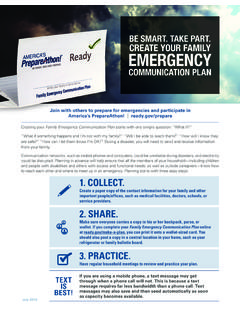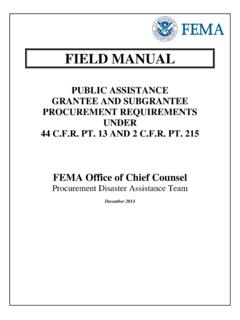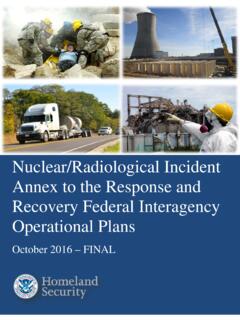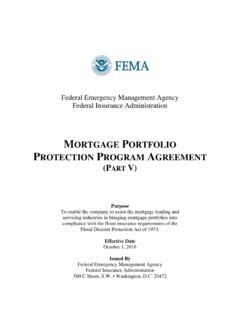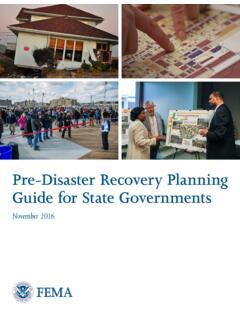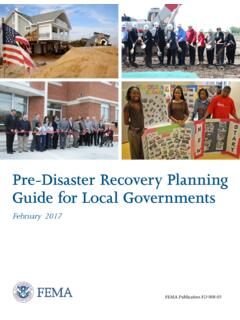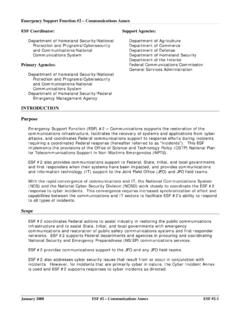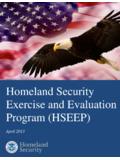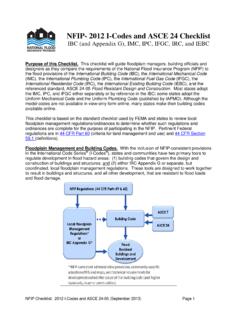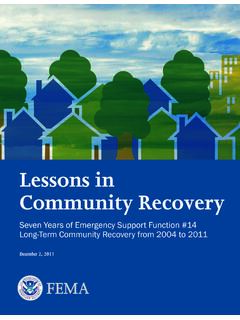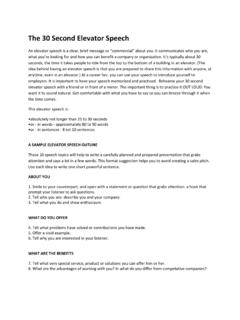Transcription of Basic Preparedness - fema.gov
1 1. Basic Preparedness In this part of the guide, you will learn Preparedness strategies that are common to all disasters. You plan only once, and are able to apply your plan to all types of hazards. When you complete Part 1, you will be able to: Get informed about hazards and emergencies that may affect you and your family. Develop an emergency plan. Collect and assemble disaster supplies kit. Learn where to seek shelter from all types of hazards. Identify the community warning systems and evacuation routes. Include in your plan required information from community and school plans. Learn what to do for speci c hazards. Practice and maintain your plan. 13. 14. Getting Informed 15. Getting Informed Are You ready ? Learn about the hazards that may strike your community, the risks you face from these hazards, and your community's plans for warning and evacuation.
2 You can obtain this information from your local emergency management of ce or your local chapter of the American Red Cross. Space has been provided here to record your answers. Hazards Ask local authorities about each possible hazard or emergency and use the work- sheet that follows to record your ndings and suggestions for reducing your family's risk. Possible Hazards and Risk Level How can I reduce my risk? Emergencies (None, Low, Moderate, or High). Natural Hazards 1. Floods 2. Hurricanes 3. Thunderstorms and Lightning 4. Tornadoes 5. Winter Storms and Extreme Cold 6. Extreme Heat 7. Earthquakes 8. Volcanoes 9. Landslides and Debris Flow 10. Tsunamis 11. Fires 12. Wild res 16. Are You ready ? Getting Informed Technological Hazards 1. Hazardous Materials Preparedness Incidents Basic 2. Nuclear Power Plants Terrorism 1.
3 Explosions 2. Biological Threats 3. Chemical Threats 4. Nuclear Blasts 5. Radiological Dispersion Device (RDD). You also can consult fema for hazard maps for your area. Go to , select maps, and follow the directions. National haz- ard maps have been included with each natural hazard in Part 2 of this guide. 17. Getting Informed Are You ready ? Warning Systems and Signals The Emergency Alert System (EAS) can address the entire nation on very short no- tice in case of a grave threat or national emergency. Ask if your local radio and TV. stations participate in the EAS. National Oceanic & Atmospheric Administration (NOAA) Weather Radio (NWR) is a nationwide network of radio stations broadcasting continuous weather informa- tion directly from a nearby National Weather Service of ce to specially con gured NOAA weather radio receivers.
4 Determine if NOAA Weather Radio is available where you live. If so, consider purchasing a NOAA weather radio receiver. Ask local authorities about methods used to warn your community. Warning System What should we do? EAS. NOAA Weather Radio 18. Are You ready ? Getting Informed Evacuating Yourself and Preparedness your Family Basic When community evacuations become necessary, local of cials provide informa- tion to the public through the media. In some circumstances, other warning methods, such as sirens or telephone calls, also are used. Additionally, there may be circumstances under which you and your family feel threatened or endangered and you need to leave your home, school, or workplace to avoid these situations. The amount of time you have to leave will depend on the hazard. If the event is a weather condition, such as a hurricane that can be monitored, you might have a day or two to get ready .
5 However, many disasters allow no time for people to gather even the most Basic necessities, which is why planning ahead is essential. Evacuation: More Common than You Realize Evacuations are more common than many people realize. Hundreds of times each year, transportation and industrial accidents release harmful substances, forcing thousands of people to leave their homes. Fires and oods cause evacuations even more frequently. Almost every year, people along the Gulf and Atlantic coasts evacuate in the face of approaching hurricanes. Ask local authorities about emergency evacuation routes. Record your speci c evacuation route directions in the space provided. Is there a map available with evacuation routes marked? Yes No 19. Getting Informed Are You ready ? Evacuation Guidelines Always: If time permits: Keep a full tank of gas in your car if an Gather your disaster supplies kit.
6 Evacuation seems likely. Gas stations may be closed during emergencies and unable to pump gas during power outages. Plan to take one car per family to reduce congestion and delay. Make transportation arrangements with Wear sturdy shoes and clothing friends or your local government if you do that provides some protection, not own a car. such as long pants, long-sleeved shirts, and a cap. Listen to a battery-powered radio and follow Secure your home: local evacuation instructions. Close and lock doors and windows. Unplug electrical equipment, such as radios and televi- sions, and small appliances, such as toasters and micro- waves. Leave freezers and re- frigerators plugged in unless there is a risk of ooding. Gather your family and go if you are in- Let others know where you are structed to evacuate immediately.
7 Going. Leave early enough to avoid being trapped by severe weather. Follow recommended evacuation routes. Do not take shortcuts; they may be blocked. Be alert for washed-out roads and bridges. Do not drive into ooded areas. Stay away from downed power lines. 20. Are You ready ? Getting Informed Community and Other Plans Preparedness Ask local of cials the following questions about your community's disaster/. emergency plans. emerge Basic Does my community have a plan? Yes No Can I obtain a copy? Yes No What does the plan contain? How often is it updated? What should I know about the plan? What hazards does it cover? In addition to nding out about your community's plan, it is important that you know what plans are in place for your workplace and your children's school or day care center. 1. Ask your employer about workplace policies regarding disasters and emer- gencies, including understanding how you will be provided emergency and warning information.
8 2. Contact your children's school or day care center to discuss their disaster pro- cedures. School Emergency Plans Know your children's school emergency plan: Ask how the school will communicate with families during a crisis. Ask if the school stores adequate food, water, and other Basic supplies. Find out if the school is prepared to shelter-in-place if need be, and where they plan to go if they must get away. In cases where schools institute procedures to shelter-in-place, you may not be permitted to drive to the school to pick up your children. Even if you go to the school, the doors will likely be locked to keep your children safe. Monitor local media outlets for announcements about changes in school openings and closings, and follow the directions of local emergency of cials. For more information on developing emergency Preparedness plans for schools, please log on to the Department of Education at 21.
9 Getting Informed Are You ready ? Workplace Plans If you are an employer, make sure your workplace has a building evacuation plan that is regularly practiced. Take a critical look at your heating, ventilation and air conditioning system to determine if it is secure or if it could feasibly be upgraded to better lter potential contaminants, and be sure you know how to turn it off if you need to. Think about what to do if your employees can't go home. Make sure you have appropriate supplies on hand. 22. Emergency Planning and Checklists Emergency Planning and Checklists Are You ready ? Now that you've learned about what can happen and how your community is pre- pared to respond to emergencies, prepare your family by creating a family disaster plan. You can begin this process by gathering family members and reviewing the information you obtained in Section (hazards, warning systems, evacuation routes and community and other plans).
10 Discuss with them what you would do if family members are not home when a warning is issued. Additionally, your family plan should address the following: Escape routes. Family communications. Utility shut-off and safety. Insurance and vital records. Special needs. Caring for animals. Saftey Skills Information on these family planning considerations are covered in the following sections. Escape Routes Draw a oor plan of your home. Use a blank sheet of paper for each oor. Mark two escape routes from each room. Make sure children understand the drawings. Post a copy of the drawings at eye level in each child's room. Where to Meet Establish a place to meet in the event of an emergency, such as a re. Record the locations below: Where to meet . Near the For example, the next door neighbor's telephone pole home Outside the For example, the neighborhood grocery store parking lot immediate area 24.
